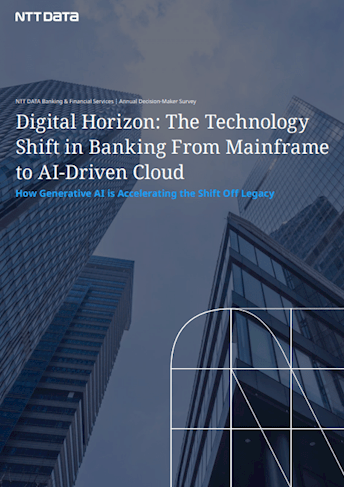The banking sector is being boldly redefined by the dual forces of Artificial Intelligence and cloud computing. As we discussed in our last blog in this series focused on our global research "The Digital Horizon: Banking’s Shift from Mainframe to AI-Driven Cloud Infrastructure," these technologies have ascended to the top of the boardroom agenda.
As industry leaders navigate a digital-first economy, they face the complex challenge of fostering a culture that not only embraces innovation but is agile enough to meet the rapidly changing demands of consumers and clients.
The Innovation Imperative
Banking's modernization and transformation initiatives has become strategic imperative. The resilience and security of mainframe systems have long been the industry's backbone. Migration has been complex and there are barriers. Yet the demand for agility and innovation is steering banks towards cloud and AI solutions. These technologies are rapidly transitioning from optional to essential, reshaping the status quo and the competitive landscape.
|
NTT DATA’s research identified four specific groups of challenges when it comes to transitioning from mainframe to the cloud.
|
Cloud Computing: The Innovation Enabler
Technology’s role, once seen as a cost centre, is being redefined. The cloud has emerged as a cornerstone and enabler of innovation, offering benefits far beyond traditional IT’s remit. Improved security protocols, operational efficiency, enhanced customer experiences, and collaborative data management are just the beginning. As 88% of banking professionals agree, the cloud is the key to unlocking personalized customer services and ensuring swift operational responses.
The Cloud and Generative AI: A powerful duo of change
Generative AI has become an executive priority, demonstrating the potential to redefine banking models and make change that lasts forever. It’s a once in a lifetime technology that will reframe how banks operate. From revolutionizing customer service, to enhance efficiency, and sharpening strategic decision-making. Change is the status quo and there’s optimism among banking leaders, with a majority viewing Generative AI as a critical enabler of modernization through cloud migration and an accelerator of digital transformation.
The Strategic Balancing Act
Banks walk a tightrope. They must retain the robustness of mainframe systems while also transitioning to the innovative potential of cloud and AI. It's a shift that requires a strategic and well-managed approach, ensuring that the security and functionality that mainframes have long provided are not lost in the transition.
This shift is transformation that touches every facet of the banking institution, demanding a change in culture, processes, and skills. Banks are at a critical juncture, where they must navigate their modernization with precision and foresight. It's essential that this journey reinforces the bedrock principles of banking—security, dependability, and the trust of customers. Trust is hard won and easily lost.
However, by leaning into AI and cloud technologies, banks have the opportunity to not only safeguard but also strengthen these core values.
Facing the Strategy Gap
Despite widespread recognition of these technologies' importance, a significant 80% of organizations admit to lacking a clear strategy for AI implementation. This gap presents an urgent call to action for decision-makers to devise robust strategies that can harness the transformative power of AI and cloud technologies.
Conclusion
"Banking in the Cloud: Navigating the Digital Transformation” is a must-read for banking decision makers, wherever you are on the journey. You’ll learn how your peers are addressing this vast challenge and opportunity. As 91% of decision-makers rally behind AI and cloud initiatives, the path forward is clear. Modernization, transformation and Innovation with AI and Cloud will boldly redefine banking’s future.

Report - 20 MIN Read
The Technology Shift in Banking in 2024
For a detailed exploration of banking's digital transformation, download the report
Download the report